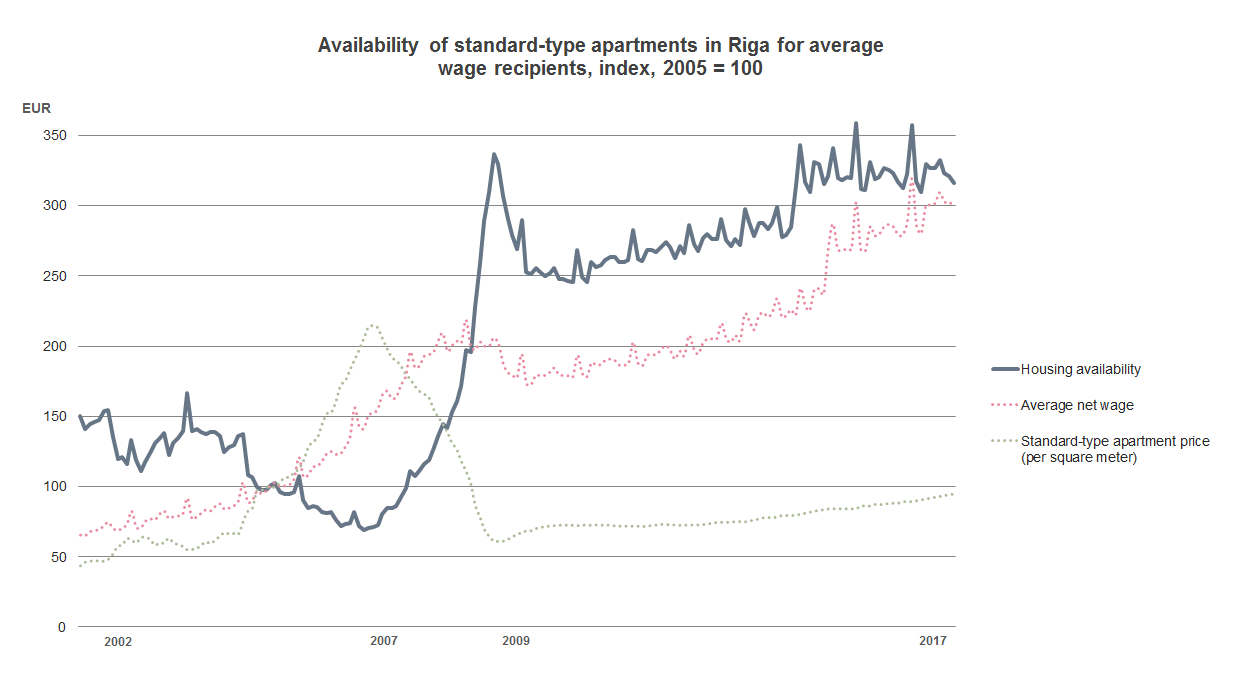The road of Latvian economy towards housing industry | Luminor

Pēteris Strautiņš
Peteris Strautins, Luminor economist
The development of the housing market is a big opportunity to promote the growth and raise the attraction of Latvia as a place for residence. In order this may happen, investments should be made. Currently we are doing it far too little. In 2016 only 2% form GDP in Latvia were invested in housing, in contrast to the average of 4.7% in Europeans Union (Eurostat data). Only Greece which is still in deep crisis invests yet even smaller part in this field from their national income. In contrast to this, in Estonia the investments in housing play bigger role in their national economy than averagely in EU. Moreover, the dynamics of the issued construction permits show that our Northern neighbours do not plan to stop. This investment in Latvia has varied almost always at approximately 2% of GDP since 1995, except the years 2005 – 2008. Thus the shortage of investments in housing has been created for a long time. The results are not satisfactory. The lack of quality is obvious, but there are some regions, where there is none more or less acceptable housing option. The list is not long, but these places create the majority of the general value added.
My house, my bank
Despite the insufficient investments for such a long period the housing owned by Latvian residents is of big value. The total market price might be approximately 30-35 billion euro. Credits issued against these properties are rather small - slightly above 4 billion euro. Well, it is true that ¾ of the value of these properties are located in Riga and near Riga and this concentration is even more explicit than in economy, as a high market price may be only in a place where there are more people willing to reside than the housing is offered.
People live in their properties and at the same time they are investments. This is a very important reason to pay more attention to this area of economics in our country, as the housing is the main or the most significant part for the majority of residents, financial wellness is tiny for the time being if we compare it with the Western Europe.
The huge proportion of housing in the personal wellness of Latvians is at the same time an opportunity and a risk.
Opportunity, as 71.7% of Latvian residents reside in properties which they own and which are not burdened with any liabilities. For comparison, in Netherlands these are only 8.0%. On one hand it is financially safe. On the other hand, here we can see unused opportunities to improve the current living conditions or to use the saved or inherited capital to co-finance the construction or purchase of a new place of residence. According to data by European Banking Federation, the balance of the mortgage loans issued by the banks in October 2017 was 16.4% of GDP, which is a very low ratio - less than a half from the respective data in Eurozone (37.5%).
Risk, in its turn, is a probability that the families will invest in futureless assets. Such may be apartments in places that undergo irreversible economic and demographic decline. To decrease this risk it is very important to clarify the prospects of different regions as soon as possible. This should be done with political decisions, and not leaving it at its own or market’s fate or maintaining illusions about impossibly huge number of the development centres with unrealistic development strategies, firstly, tourism. If I may express a rather harsh hint, the number of sustainable centres should not exceed twenty and they should be located near cities and towns, if we are optimistic. For bigger number there are not and will not be enough resources - neither people, nor assets.

Nice housing makes the country attractive
A bigger number of really attractive housing options will make Latvia a competitive place of residence. If a person owns a valuable and comfortable place to live, it makes strong emotional and practical ties with his/her country. One may object that there are lots of dwellings in our country if we compare this to the number of households. It is true, but they are generally of rather low quality, small, and lots of them are located in places, where people no more like to live. In places, where they want to be, the living conditions are far from excellent. On average in Latvia each member of family owns 1.2 rooms, while in EU this number is 1.6.
Among other EU countries in Latvia there is the highest number of those residents who live in buildings with at least 10 apartments. In 2016 we had 58.1% of such people, while in Belgium and Great Britain it is less than 10%, but in EU 24.0% on average. This category also contains the exclusive apartments in the very centre of the city (Klusais centrs) and Jurmala, yet the majority of the residential places in this category are neither big nor beautiful. A part of those residing in serial apartment buildings will move to private houses in suburbs or more spacious apartment buildings. Rather often their places will be taken by those, for whom this serves as their first step in the city life, which is why the mentioned proportion will slightly change in the nearest future, thus at least reaching a more sustainable disposition of residents on the territory of the country.
Housing earns, but not directly
Renewal and construction of housing premises will create new workplaces and income. It is clear that construction of housing may not be the main guide of the development – it is not an asset that allows earning money. However the significant dominance of the increased savings over the growth in crediting means that investments in this area may be increased sustainably. Moreover, although the housing cannot be exported directly, it helps to improve the export ability of our country indirectly.
Renovation and construction of residential premises will mainly take place in locations that have highest potential for development – capital city and regions of some more cities. It will give an opportunity for a bigger number of people from the rest of Latvia to move here. The decrease of population in the majority of country cannot be avoided. We do not know, where these people will move – to more economically dynamic places in Latvia or further. The movement of people to bigger cities will increase the ability of growing industries and companies to employ them thus decreasing the so called structural unemployment. If earlier banks lent the money first to companies, for them to build the factories in places where people reside more, then in future they will provide finances to people, so that they can live closer to their workplaces in office buildings. It is not the choice of the banks - increasingly the bigger part of economy is formed of the smart services, which hopelessly “love” big cities, as there are sufficient number of employees and variety of knowledge.
Construction and renovation of houses promotes the development of manufacturing and services. For instance, this provides excellent opportunities for wood-processing industry. Majority of its products may be easily exported. However the distance may be a significant obstacle in the sales of high quality furniture, as it may not be easily packed and requires the shipment by air. One may export even houses and wooden constructions, nevertheless for the development of these sectors it is required to have a strong local market. Similarly the construction industry is an important customer for chemical industry, where very few small Latvian companies compete in a game, the rules of which is written by global giant companies, however the personal connections in the local market, recognition and patriotism of buyers provide some relief.
Risks exist in a far distance for the time being.
Not all is rosetinted and not all circumstances speak of healthy development of residential market neither in the nearest, nor in a distant future. This and the coming year will be the time when Latvian economy will receive a solid dose of vitamins. It will grow quickly, even if the field described herein will remain in stagnation. Factors are well known, that is why I will only name them shortly – EU funds, launch of RailBaltica construction, strong development in the markets of other countries in combination of the rapid growth of our export industries. There always may happen a global crisis, those cannot be anticipated (otherwise they would not take place at all), but the base scenario is a growth of GDP, which will give the resources of our economy a full time job.
That is why it seems that housing market in the coming 2-3 years will be like a bottle of champagne, which is corked up and seriously shaken. The strong internal and external demand will create number of workplaces in the central part of the country. In this case the common tendencies of demographics will be of no significance - the number of taken workplaces in Riga since 2011 has grown for ~2% per year, even when everybody spoke about stagnation in economy. Unemployment in Valmiera and Ventspils is no bigger than in the capital anymore.
Respectively, the demand for apartments will grow, but the possibilities to build them will be limited, as the resources of the industry will be busy elsewhere. It may lead to the increase of prices, which may start “to live a life of its own". The cycles of real estate property and crediting can for some time exist from the energy they generate themselves, circling along the range of workplaces, salaries, prices and growing optimism. For the time being there is only a theoretical risks, as the situation is rather opposite, but we have to keep it mind.
Pēteris Strautiņš
Economist
[email protected]
For media contacts: Lita Juberte-Krumina
